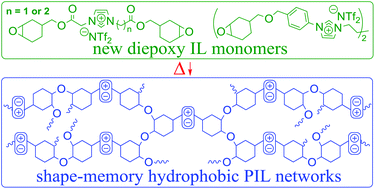Cycloaliphatic epoxidized ionic liquids as new versatile monomers for the development of shape memory PIL networks by 3D printing†
Abstract
An efficient access to Cycloaliphatic Epoxy-Functionalized Ionic Liquids (CEILs) containing one or two imidazolium units was described for the first time. Due to the flexibility/versatility of the reported methodology, the synthesis of tailor-made ionic cycloaliphatic epoxy monomers was performed on a multigram scale (up to 25 g) in order to design a new generation of poly(ionic liquid) networks which can be processed by thermal curing or stereolithography (SLA) 3D printing. Thus, the influence of diaryliodonium hexafluoroantimonate acting as the thermoacid generator on the reaction kinetics and the properties of the resulting networks were investigated. It was clearly demonstrated that the presence of the initiator led to an increase of the crosslinking rate. As a consequence, a poly(ionic liquid) network with a higher Tα (96 vs. 117 °C at 1 Hz) as well as thermo-mechanical properties in the rubbery state (G′200 °C 5.88 vs. 1.84 MPa) was prepared. Compared to the network cured without an initiator, the ones containing the thermo-acid initiator display high hydrophobicity (water contact angle of 112°). Moreover, all the networks designed from CEILs present shape memory behavior with excellent shape retention and recovery.



 Please wait while we load your content...
Please wait while we load your content...